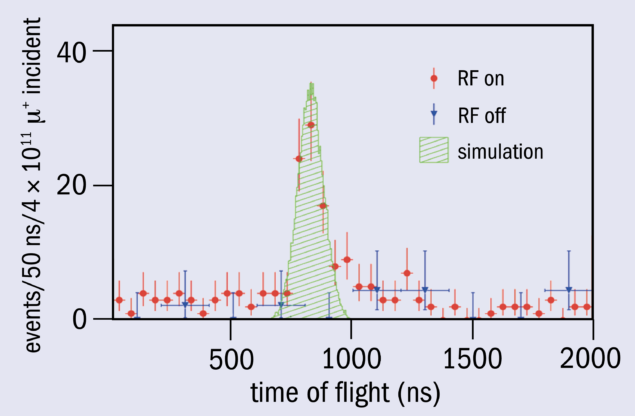
Muons have been accelerated by a radio-frequency accelerator for the first time, in an experiment performed at the Japan Proton Accelerator Research Complex (J-PARC) in Tokai, Japan. The work paves the way for a compact muon linac that would enable precision measurements of the muon anomalous magnetic moment and the electric dipole moment.
Around 15 years ago, the E821 storage-ring experiment at Brookhaven National Laboratory (BNL) reported the most precise measurement of the muon anomalous magnetic moment (g-2). Achieving an impressive precision of 0.54 parts per million (ppm), the measured value differs from the Standard Model prediction by more than three standard deviations. Following a major effort over the past few years, the BNL storage ring has been transported to and upgraded at Fermilab and recently started taking data to improve on the precision of E821. In the BNL/Fermilab setup, a beam of protons enters a fixed target to create pions, which decay into muons with aligned spins. The muons are then transferred to the 14 m-diameter storage ring, which uses electrostatic focusing to provide vertical confinement, and their magnetic moments are measured as they precess in a magnetic field.
The new J-PARC experiment, E34, proposes to measure muon g-2 with an eventual precision of 0.1 ppm by storing ultra-cold muons in a mere 0.66 m-diameter magnet, aiming to reach the BNL precision in a first phase. The muons are produced by laser-ionising muonium atoms (bound states of a positive muon and an electron), which, since they are created at rest, results in a muon beam with very little spread in the transverse direction – thus eliminating the need for electrostatic focusing.

The ultracold muon beam is stored in a high-precision magnet where the spin-precession of muons is measured by detecting muon decays. This low-emittance technique, which allows a smaller magnet and lower muon energies, enables researchers to circumvent some of the dominant systematic uncertainties in the previous g-2 measurement. To avoid decay losses, the J-PARC approach requires muons to be accelerated via a conventional radio-frequency accelerator.
In October 2017, a team comprising physicists from Japan, Korea and Russia successfully demonstrated the first acceleration of negative muonium ions, reaching an energy of 90 keV. The experiment was conducted using a radio-frequency quadrupole linac (RFQ) installed at a muon beamline at J-PARC, which is driven by a high-intensity pulsed proton beam. Negative muonium atoms were first accelerated electrostatically and then injected into the RFQ, after which they were guided to a detector through a transport beamline. The accelerated negative muonium atoms were identified from their time of flight: because a particle’s velocity at a given energy is uniquely determined from its mass, its type is identified by measuring the velocity (see figure).
The researchers are now planning to further accelerate the beam from the RFQ. In addition to precise measurements in particle physics, the J-PARC result offers new muon-accelerator applications including the construction of a transmission muon microscope for use in materials and life-sciences research, says team member Masashi Otani of KEK laboratory. “Part of the construction of the experiment has started with partial funding, which includes the frontend muon beamline and detector. The experiment can start properly three years after full funding is provided.”
Muon acceleration is also key to a potential muon collider and neutrino factory, for which it is proposed that the large, transverse emittance of the muon beam can be reduced using ionisation cooling (see Muons cooled for action).
Further reading
S Bae et al. 2018 Phys. Rev. Accel. Beams 21 050101.





